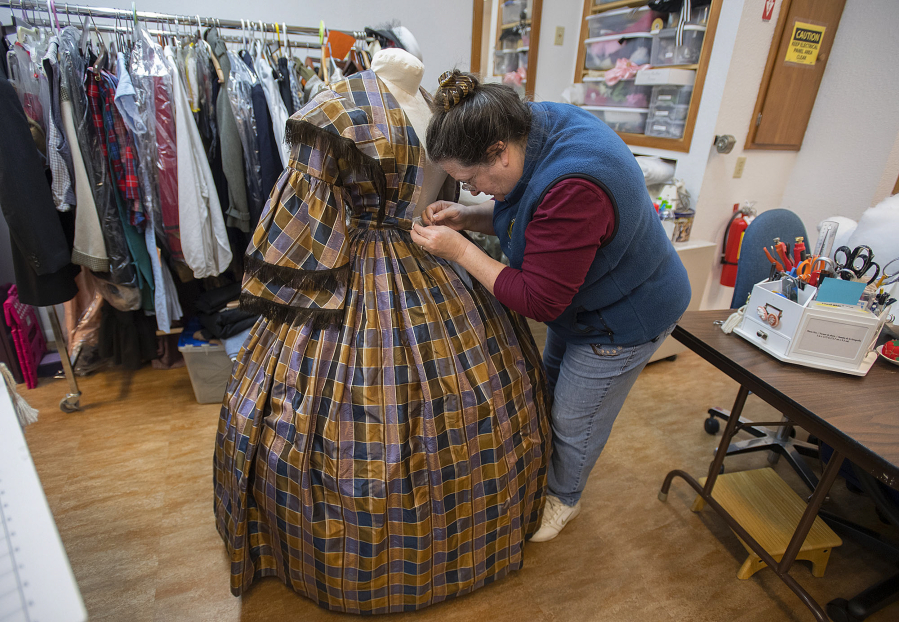After some serious seamstressing by Eileen Trestain, the pretty silk dress is back home at the Barclays.
The dress was worn by Maria Pambrun Barclay, one of the founding mothers of Fort Vancouver in the 1840s. Her purple-and-copper plaid dress was recently acquired by Fort Vancouver National Historic Site.
“As you might imagine, it is not common to come across something that belonged to one of the women of Fort Vancouver,” museum curator Tessa Langford said.
Trestain prepared it for display at the site’s McLoughlin House Unit in Oregon City, Ore.
Maria Pambrun Barclay
Born in 1826, Maria Pambrun was the eldest daughter of Pierre-Chrysologue Pambrun, a Hudson’s Bay Company chief trader, and his wife, Catherine. While living at Fort Walla Walla in 1841, he died after falling from a horse. Catherine Pambrun moved with her children to Fort Vancouver, where she did needlework to support her family. Maria married Dr. Forbes Barclay, the fort’s physician, in 1842. They lived at Fort Vancouver until 1850, when they retired to Oregon City, Ore. She died in 1890.
IF YOU GO
• The McLoughlin House, 713 Center St., Oregon City, Ore., is open for free tours Fridays and Saturdays from 10 a.m. to 4 p.m. The McLoughlin House Unit includes the Barclay House.
• Meagan Huff, assistant curator, will discuss historic women of Fort Vancouver at 1 p.m. Friday at the McLoughlin House, where Maria Pambrun Barclay’s dress is on display.
After working stitch by stitch on clothing of a woman born in 1826, you feel like you know her, said Trestain, manager of Fort Vancouver’s costume department.
Langford said she has her own personal connection to Maria. (It was pronounced “mar-I-a,” she said.)
“I used to do living-history interpreting and played her for many years,” Langford said. “I find her story fascinating: someone with a background of different ethnicities, a bridge between different cultures and languages and social standards.”
Maria’s mother was part native; her father was a French-Canadian who had fought against the United States in the War of 1812; and her husband was Scottish.
“For me, she is a quintessential example of the women of the unique fur-trading world,” Langford said. “As cultures and languages came together, it created something new.”
The silk dress represented a later chapter in the lives of Dr. Forbes and Maria Barclay, who left Fort Vancouver in 1850 and retired to Oregon City. (The Barclay House is part of the McLoughlin House Unit of Fort Vancouver.)
Based on design, the dress was sewn about 1855, Trestain said.
Even though the fabric is silk, “it was an everyday dress. That doesn’t mean it was for cooking and cleaning, because she wouldn’t do that,” Trestain said.
“Maria would have had several dresses,” she said. They would have included “a cotton wrapper in the morning, like a robe; and an evening dress, with a lower neckline and open sleeves, depending on how the Barclays were entertaining.”
And whatever dress Maria wore was just the top layer of that day’s wardrobe.
“She wore drawers, a chemise, a corset and multiple petticoats,” Trestain said.
To mount the dress on a seamstress’s mannequin for display at the McLoughlin House, Trestain filled out the skirt with a hoop from the costume collection. The hoop is 98 inches around.
Based on measurements of the skirt and bodice, Maria would have been about 5-foot-1 or 5-foot-2. Her bust was 38 inches and she had a 24-inch waist.
Fun of discovery
Trestain described the fabric pattern as an unbalanced, or unsymmetrical, plaid. She knows that the colors of purple and copper aren’t as vibrant as they once were — and not just because purple fades over time. Trestain found leftover pieces of fabric stuffed in a dress pocket.
“They show the original colors of the fabric, as opposed to how it’s faded now. That’s the fun of discovery.”
Fun of discovery also describes how Fort Vancouver acquired the dress after a museum decided to sell it.
“Last year we received a notice from an auction house that a dress formerly belonging to Maria Pambrun Barclay was coming up soon,” Langford said.
She noted that most museums “have a scope of collection, based on their mission. They felt (the dress) was outside their scope.”
While all parties were anonymous, “we did learn that the dress had remained in the family for some time and was donated by one of them to a small historic museum in the Pacific Northwest.”
After Trestain confirmed that the fabric and style were appropriate, Langford said, “We felt comfortable enough with the provenance to put in a bid.”
Their winning bid of $1,140 meant that the dress most likely coming through Fort Vancouver on its way to Oregon City for the second time.
That likely was the route in 1855, when Mrs. Barclay bought it. At that point, Vancouver no longer was a frontier outpost.
“Anything you could get in San Francisco, you could get here in Vancouver,” Trestain said. “Shops in Oregon City would advertise that ships would be arriving with goods.”




